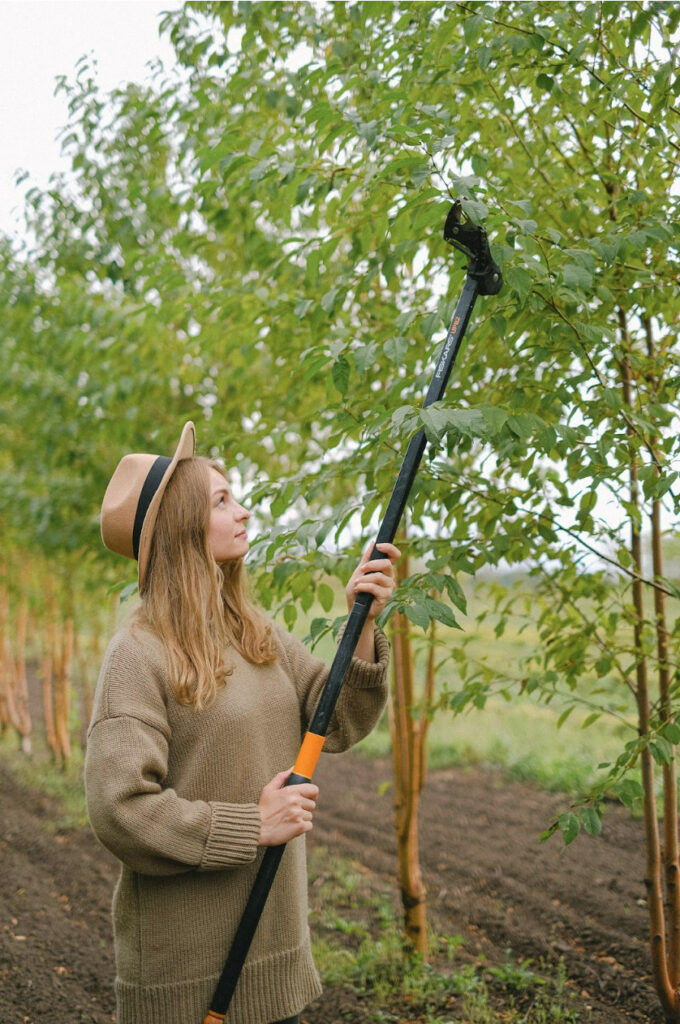
Regular trimming makes sure that trees grow in the spring and that they don’t concentrate all of their energy on a lot of smaller branches. Proper pruning helps shape plants, control growth, and encourage dense foliage.
In this blog, we’ll discuss the best times for trimming shrubs and hedges, and share pruning techniques that will have your shrubs and trees looking like they were professionally trimmed.
When to trim
The best time to trim largely depends on the specific plant species, as well as your climate zone. However, there are general guidelines to follow:
Spring Trimming
For most shrubs and hedges, spring is an excellent time for maintenance trimming. Wait until after the plant’s spring bloom to avoid removing flower buds.
Early spring, before new growth emerges, is ideal for shaping and light pruning.
Floral shrubs
Spring-blooming shrubs should be pruned as soon as the flowers have faded. Why? If you wait too long to prune after the flowers have bloomed, you will be eliminating stems that would have produced flowers the next spring. For example, flowers that bloom on last season’s growth (old wood) include woody plants like rhododendrons, dogwoods, lilacs, forsythia, and some hydrangeas.
Summer-flowering shrubs should be pruned in late winter or early spring to encourage brisk growth in the spring. Why? Flowers open up from buds that have grown this season (new wood). Among them are Japanese spirea, bush honeysuckle, rose-of-Sharon, summersweet, and panicle hydrangea.
Pruning in the early spring helps prevent accidentally cutting away any stems that may have developed blossoms and encourages these shrubs to concentrate their growth on the freshly cut sections.
Roses
Roses should be pruned in the spring by removing all dead wood. Just above a bud that faces outward, trim the canes back to healthy, living wood. The bush should then be pruned to achieve the ideal height and form.
Evergreen shrubs
If you haven’t already done it in the fall, you can trim evergreen shrubs in the early spring, before new growth appears. Hedge shears can be used to shape and encourage new growth on plants like yew and privet that are used in formal hedges and foundation plantings.
Other examples are boxwood, juniper, and arborvitae. Evergreen bushes like junipers should be pruned from the bottom up. By pruning them back to a lower branch that is below an overhanging branch, you can shorten branches that are growing longer than you want them to. This gives the cuts a cleaner appearance because the branches above cover them.
Fruit trees and shrubs
Early in the spring, prune any shrubs and trees that bear fruit. Better if done sooner. Pruning can be done whenever it’s warm enough outside and before the start of the spring growth cycle. Fruit trees should be pruned to create greater inner space so that more light may reach the crown and improve fruit production.
Note that different fruit trees require different pruning techniques. There are some differences among particular varieties, even within a species. Consult your local nursery, garden center, or extension agent for detailed directions.
Fall Trimming
Late summer or early fall is a good time for trimming evergreen shrubs and hedges. This allows new growth to harden before winter. Avoid significant pruning in late fall, as it may stimulate new growth that is susceptible to frost damage.
Things you should trim at this time include:
Dead tree limbs: This is crucial in regions that frequently experience heavy snowfall or ice.
Shrub roses: Pruning shrub roses is best done in the winter or early spring, when the plants are dormant. However, pruning to remove 2 to 4 inches of canes from large or overgrown shrub rose bushes can help protect the plant if you live in a region where heavy snowfalls could break canes. Remove the problematic canes if shrub roses have taken over walkways. Pruning should be delayed until several hard freezes have passed to avoid spurring new growth.
Disease-prone perennials: This category includes bearded iris, hollyhocks, and any plants that are susceptible to powdery mildew, including peonies, bee balm, and garden phlox. Trim stems to 2 to 4 inches in length, then discard (do not compost) the prunings.
Suckers: Some plants produce new growth at the original plant’s base or in close proximity to it. Suckering shrubs allow a single plant to eventually grow into a colony. Examples include colored twig dogwoods, kerria, saucer magnolias, witch hazel, and sumac. When you see suckers, cut them as close to the base as you can and get rid of them.
Plants vulnerable to slugs: Since slugs lay their eggs in the fall, trim the stems and leaves of hosta, delphinium, lupine, and any other susceptible plants. Instead of composting the trimmings, get rid of them.
Trimming tips
Use the Right Tools
Invest in quality pruning tools, including sharp bypass pruners, hedge shears, and hand saws, depending on the size and thickness of the branches.
Start with branches that are dead, sick, or damaged
Begin by removing any dead, diseased, or damaged branches. Cut them back to healthy wood or the base of the shrub.
Keep the shape natural
Preserve the natural form of the shrub or hedge while trimming. Avoid over-pruning, as it can weaken the plant and negatively impact its aesthetics.
Make the shape tapered
When trimming hedges, follow a slightly tapered shape, with the base wider than the top. This allows sunlight to reach the lower branches and promotes even growth.
Make clean cuts
Use clean, angled cuts just above a bud or lateral branch. Avoid leaving stubs or cutting too close to the main stem, as it may interfere with proper healing.
Pause, step back and examine your work
Regularly step back while trimming to evaluate the overall shape and symmetry of the shrub or hedge. This ensures a balanced and visually pleasing appearance.
If you want your plants to remain healthy and maintain their aesthetic appeal, it’s important to trim your bushes and tall plants at the right time. Think about what each plant needs and the climate where you live when deciding when to prune.
If you follow these tips and pay attention to how your plants naturally grow, you can have attractive and thriving bushes and hedges that make your outdoor space even more beautiful.
Tree Trimming Tips and Techniques
10 Cheap Landscaping Ideas That Won’t Bust Your Budget
3 Different Kinds of Home Maintenance and What These Mean to You


